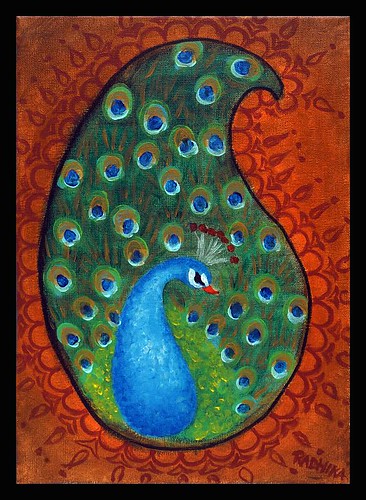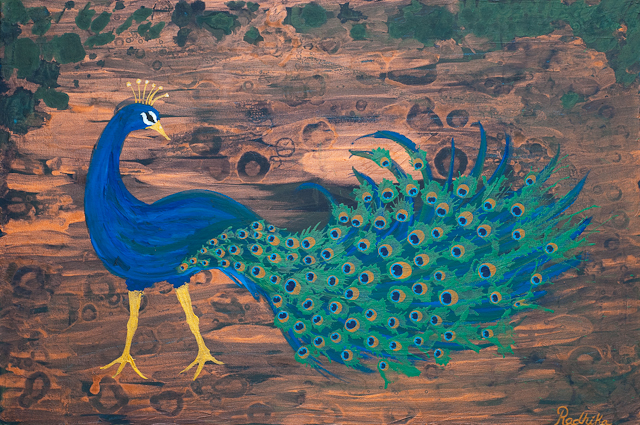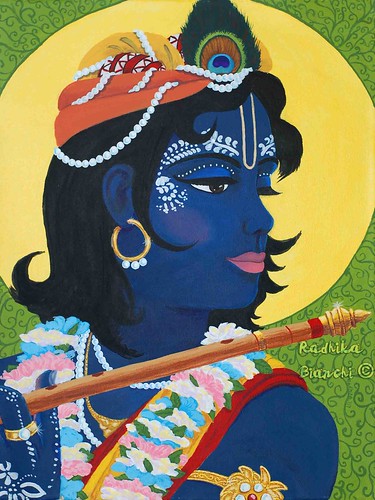Dance is an exquisite art portrayed through music and movement. It is a very involved form of expression which uses the heart, mind, body, and senses; and in the case of Vedic dance- the soul.

In India dance is a way of worshipping God. The dance is treated like an offering to God and the movements are like prayers to please the Lord. There are other dances that are more like dance-dramas, where the actors or dancers re-enact the pastimes and stories of the various gods.
There are several types of traditional dance offerings that come from different parts of India, such as Odissi, Bharatanatyam, Manipuri, Sattriya, Kathak, Kuchipudi, Mohiniattam, and Kathakali.
Odissi Odissi
Odissi (oh-di-see) comes from the state of Orissa, in eastern India by the Bay of Bengal. It is a very ancient dance form that was traditionally performed in the temples of Vishnu by the devdasis (women who would spend their entire lives in the temple serving the Lord with devotional dance offerings). There is evidence of the antiquity of Odissi on the ancient temples in Orissa, where many carvings depict the dancers in various traditional Odissi poses.
The costume is unique to other Indian dances in that the jewellery is almost always silver, instead of gold, and the female dancers wear crowns of white flowers in their hair, and the sarees are cotton handloom in the traditional Orissan style. This dance is gorgeously graceful. A good Odissi performance will take the audience's breath away with it's beauty and elegance.
Watch an Odissi performance.Bharatanatyam Bharatanatyam
Bharatanatyam (ba-raat-nat-yum) comes from the state of Tamil Nadu in southern India. This dance is characterized by elaborate hand gestures called
mudras, fast-pace movement, and stamping of the feet. The costumes are traditionally made of colourful silk sarees with elaborate borders. This dance is performed by both men and women, although women tend to dominate it.
Like Odissi, Bharatanatyam is a dance of devotion and it was originally performed exclusively in the temples as an offering to Vishnu. Over time the dance moved out of the temple halls and into the stages of the wealthy upper class of India.
Watch a Bharatanatyam performance.ManipuriManipuri (maa-nee-poo-ree) comes from the state of Manipur in far east India. Manipuri dance is very sweet and graceful, and because Manipur is so close to China the dance has a hint of oriental style to it. The dancers wear elaborate costumes which are famous for the wide tube-like skirts and white veils. Most of the movement is in the hands and it is graceful like a flowing river.
Manipuri dance usually depicts Krishna and the gopis dancing together in the moonlight. This dance is called the Rasa Leela and is the most popular piece in Manipuri dance theatre.
See Manipuri dancing.SattriyaSattriya is a dance from the state of Assam, in far east India. I don't know much about this dance form, in fact I only heard of it when I started writing this article! But I had to include it because it is one of the 8 classical Indian dances, and after watching a few videos I decided I like it.
Sattriya dancers wear traditional Assamese outfits with colourful prints and designs. The movement of the dance is soft and graceful, with many hand gestures and no stamping. It is a very elegant and gentle form of dance.
Watch a Sattriya performance.Kathak Kathak
Kathak (kaa-tuck) comes from northern India. Kathak dance is different from the other types of dance beacause it has both Hindu and Muslim influences. Some say that the style of dance was a fusion of Indian and Persian culture and this is evident in the costume. Female Kathak dancers generally wear long flowing skirts over trousers and
kamis tops, which are typical of Muslim outfits. The style of this dance has a lot of stamping with loud bells on the feet and and many pirouettes and spins. Kathak is especially famous for its spins. The dance is very fast pace and energetic. When the dancers spin their skirts flare out beautifully. A good Kathak dance is quite a spectacle.
Watch a Kathak performance.MohiniattamMohiniattam (mo-hee-nee-ah-tum) comes from the state of Kerala in south-west India. This dance is traditionally performed by women wearing beautiful white sarees with ornate gold borders. The costume is unique in that the women always wear their hair in a large bun to the side of their head.
Mohiniattam means "dance of the enchantress". It is given this name because the dance is inspired by the goddess Mohini, an avatar of Vishnu, who used her charms to enchant the demons and keep them away from the nectar of immortality. Therefore, the Mohiniattam style is identified by the slow, seductive movement of the hips and upper body, sweet smiling, and coy movements of the eyes.
Watch a Mohiniattam performance.Kuchipudi Kuchipudi
Kuchipudi (koo-chee-pu-dee) comes from the state of Andhra Pradesh in south-east India. The dance costume is very similar to that of Bharatanatyam, and the dancers are usually tall and slender (compared to Odissi dancers). The movements are quick and rounded. Kuchipudi is very unique in that the dancers sometimes dance on brass plates, balancing on the raised edges.
Kuchipudi also has devotional roots and is something of a dance-drama. The dancers perform tales of Shiva, Krishna, etc. with dramatic expressions and movements.
Watch a Kuchipudi performance.KathakaliKathakali (kaa-ta-kaa-lee) also comes from Kerala in south-west India. Kathakali is more of a drama than a dance, but is performed to music and rhythm. The Kathakali costume is very colourful; the actors paint their faces in bright colours, wear large heavy headresses, and huge fluffy dresses. The actors are usually men.
Kathakali performances re-enact stories like the Ramayana, Krishna Leela, and tales of various gods and goddesses.
Watch a Kathakali performance.There are other types of dance that sprout from India, many having roots from vedic literature.
ApsarasApsaras are celestial nymphs who dance in the court Indra, the King of Heaven. They are famous for their talent and extraordinary beauty.
In Cambodia and parts of Indonesia there are women called Apsaras who are trained to dance gracefully and beautifully. They wear gorgeous crowns and slim, body-fitting dresses with gorgeous ornaments and flowers in their hair. This type of dance is very soft and gentle, most of the movement is in the hands. There is absolutely no stamping feet and jumping around, the girls remain poised throughout the dance.
Watch the Apsaras performing.The Rasa LeelaThe Rasa Leela is a dance which was originally performed by Krishna and the beautiful gopis of Vraja about 3000 years BC. This is the most famous dance in all of India and different variations of it are performed by the different schools of dance. Folk dancers generally perform the Rasa Leela using wooden sticks and tapping them together. This is a very sweet and simple dance, and became famous worldwide due to the film
Lagaan, which has a Rasa Leela stick dance scene.
Watch the Kuchipudi version of Rasa Leela.One of my drawings, the painting of the dancer above is also done by me.
Dancer in Vrindavan

*All photos are taken by Sanatan John Howchin.
































